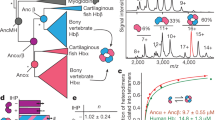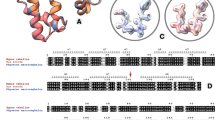Abstract
Several simplifying structural principles have been developed from the considerable data contained in the three-dimensional structures of proteins determined in the past two decades. One of these is based on the observation that particular folding motifs often occur in a variety of structural and functional settings1. The compact bundle of four antiparallel α-helices2, first seen in the structure of myohaemerythrin3, is an example. Several non-haemerythrin proteins have since been found to have the same folding pattern4–7, and haemerythrins themselves exist in a wide variety of quaternary arrangements8,9. The unusual ability of the haemerythrin fold to associate as dimers, trimers, tetramers, octamers or higher aggregates provides an opportunity for examining structural diversity in subunit association. We have used X-ray crystallography to study the subunit structure of trimeric haemerythrin from a Siphonosoma species. We report here that the pattern of intersubunit helix–helix interactions differs from the most common mode of association of other helix-bundle proteins. In a novel approach to structure analysis at low resolution, experimental phases for the structure determination were based on anomalous scattering from the iron atoms native to haemerythrin, using the new resolved-anomalous phasing procedure10.
This is a preview of subscription content, access via your institution
Access options
Subscribe to this journal
Receive 51 print issues and online access
$199.00 per year
only $3.90 per issue
Buy this article
- Purchase on Springer Link
- Instant access to full article PDF
Prices may be subject to local taxes which are calculated during checkout
Similar content being viewed by others
References
Richardson, J. S. Adv. Protein Chem. 34, 167–339 (1981).
Weber, P. C. & Salemme, F. R. Nature 287, 82–84 (1980).
Hendrickson, W. A., Klippenstein, G. L. & Ward, K. B. Proc. natn. Acad. Sci. U.S.A. 72, 2160–2164 (1975).
Champness, J. N., Bloomer, A. C., Bricogne, G., Butler, P. J. G. & Klug, A. Nature 259, 20–24 (1976).
Banyard, S. H., Stammers, D. K. & Harrison, P. M. Nature 271, 282–284 (1978).
Mathews, F. S., Bethge, P. H. & Czerwinski, E. W. J. biol. Chem. 254, 1699–1706 (1979).
Weber, P. C. et al. Nature 286, 302–304 (1980).
Hendrickson, W. A. & Smith, J. L. in Invertebrate Oxygen-Binding Proteins: Structure, Active Site and Function (eds Lamy, J. & Lamy, J. ) 343–352 (Marcel-Dekker, New York, 1981).
Addison, A. W. & Dougherty, P. L. Comp. Biochem. Physiol. 72 B, 433–438 (1982).
Hendrickson, W. A. & Teeter, M. M. Nature 290, 107–113 (1981).
Liberatore, F. A., Truby, M. F. & Klippenstein, G. L. Archs Biochem. Biophys. 160, 223–229 (1974).
Addison, A. W. & Bruce, R. E. Archs Biochem. Biophys. 183, 328–332 (1977).
Ward, K. B., Hendrickson, W. A. & Klippenstein, G. L. Nature 257, 818–821 (1975).
Stenkamp, R. E., Sieker, L. C., Jensen, L. H. & Loehr, J. S. J. molec. Biol. 100, 23–34 (1976).
Klippenstein, G. L., Cote, J. L. & Ludlam, S. E. Biochemistry 15, 1128–1136 (1976).
Klippenstein, G. L., Holleman, J. W. & Klotz, I. M. Biochemistry 7, 3868–3878 (1968).
Loehr, J. S., Lammers, P. J., Brimhall, B. & Hermodson, M. A. J. biol. Chem. 253, 5726–5731 (1978).
Bott, R. R., Navia, M. A. & Smith, J. L. J. biol. Chem. 257, 9883–9886 (1982).
Hanson, J. C., Watenpaugh, K. D., Sieker, L. & Jensen, L. H. Acta crystallogr. A 35, 616–621 (1979).
Smith, J. L. & Hendrickson, W. A. in Computational Crystallography (ed. Sayre, D. ) 209–222 (Oxford, New York, 1982).
Rossmann, M. G. Acta crystallogr. 14, 383–388 (1961).
Crowther, R. A. in The Molecular Replacement Method (ed. Rossmann, M. G. ) 173–178 (Gordon & Breach, New York, 1972).
Hendrickson, W. A. & Lattman, E. E. Acta crystallogr. B 26, 136–143 (1970).
Hendrickson, W. A. & Ward, K. B. J. biol. Chem. 252, 3012–3018 (1977).
Bernstein, F. C. et al. J. molec. Biol. 112, 535–542 (1977).
Watson, H. C. & Kendrew, J. C. Nature 190, 670–672 (1961).
Sheridan, R. P., Levy, R. M. & Salemme, F. R. Proc. natn. Acad. Sci. U.S.A. 79, 4545–4549 (1982).
Stubbs, G., Warren, S. & Holmes, K. Nature 267, 216–221 (1977).
Sieker, L. C. et al. J. molec. Biol. 148, 493–494 (1981).
Author information
Authors and Affiliations
Rights and permissions
About this article
Cite this article
Smith, J., Hendrickson, W. & Addison, A. Structure of trimeric haemerythrin. Nature 303, 86–88 (1983). https://doi.org/10.1038/303086a0
Received:
Accepted:
Issue Date:
DOI: https://doi.org/10.1038/303086a0
This article is cited by
-
Anomalous diffraction tackles phasing
Nature (2014)
-
Molecular Evolution and Phylogeny of Sipunculan Hemerythrins
Journal of Molecular Evolution (2006)
-
3.2 Å structure of the copper-containing, oxygen-carrying protein Panulirus interruptus haemocyanin
Nature (1984)
Comments
By submitting a comment you agree to abide by our Terms and Community Guidelines. If you find something abusive or that does not comply with our terms or guidelines please flag it as inappropriate.



